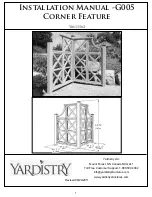
www.tridonic.com
9
Subject to change without notice. Information provided without guarantee.
Data sheet 09/22-EM080-23
Emergency lighting units
EM converterLED
4. Mechanical values
4.1 Housing properties
• Casing manufactured from polycarbonate.
• Type of protection: IP20
• Max. torque at the mounting screws: 0.8 Nm
4.2 Mechanical data accessories
LED status indicator
• Green
• Mounting hole 6.5 mm diameter, 1 – 1.6 mm thickness
• Lead length 0.3 m / 0.6 m / 1.0 m
• Insulation rating: 90 °C
• Plug connection
Test switch
• Mounting hole 7.0 mm diameter
• Lead length 0.55 m
• Plug connection
Battery connection
• Plug connection 0.3 m
• Extension 0.5 m
3.6 Maximum lead length
LED
3 m (6 m loop)
1
Status indication LED
1 m
Batteries
0.8 m
3.7 Use of different phases
The use of different phases for switched line and unswitched line is allowed.
When using different phases, the unswitched line must fail if the switched
line fails. This is required to assure correct switching into emergency mode. It
can be realised with a relay.
3.4 Loose wiring
Loosen wire through twisting
and pulling or using a Ø 1 mm
release tool
3.5 Wiring guidelines
• The output to the LED is DC but has high frequency content, which should be
considered for good EMC compliance.
• Separate LED leads from the mains and DALI connections and wiring for good
EMC performance.
• Maximum lead length on the LED terminals is 3 m. For a good EMC
performance keep the LED wiring as short as possible.
• Route the secondary wires (LED module) in parallel to ensure good EMC
performance.
• Maximum lead length for the Test switch and Indicator LED connection is
1 m. Separate the test switch and Indicator LED wiring from the LED leads to
prevent noise coupling.
• Battery leads are specified with 0.5 mm cross section and a length of 0.8 m
• Protect the wiring against short circuits to earth (sharp edged metal parts,
metal cable clips, louver, etc.) to avoid the damage of the control gear.
To ensure that a luminaire containing LED emergency units complies with
EN 55015 for radio frequency conducted interference in both normal and
emergency mode it is essential to follow good practice in the wiring layout.
Within the luminaire route the switched and unswitched 50 Hz supply wiring
as short as possible and keep it as far away as possible from the LED leads.
Through wiring may affect the EMC performance of the luminaire.
Do not exceed the max. length of LED leads to the LED module. Note that the
length of the EM converterLED leads to the LED module is added to the length
of the leads from the LED driver to the EM converterLED module when conside-
ring the max. permitted lead length of the LED driver.
1
Note: The length of LED leads to the LED module must not be exceeded. Note that the length
of the EM converterLED leads is added to the length of the leads from the LED driver to the EM
converterLED module when considering max. permitted lead length of the LED driver. Leads
should always be kept as short as possible.
5. Electrical values
5.1 Maximum loading of automatic circuit breakers
Automatic circuit breaker type
B10
B13
B16
B20
C10
C13
C16
C20
Inrush current
Installation Ø
1.5 mm
2
1.5 mm
2
1.5 mm
2
2.5 mm
2
1.5 mm
2
1.5 mm
2
1.5 mm
2
2.5 mm
2
I
max
time
EM converterLED BASIC MH/LiFePO4 250V
90
130
130
130
180
260
260
260
10 A
120 μs
5.2 Insulation matrix
When using a non-SELV LED driver insulate the
battery, LED, test switch and indicator LED in the
luminaire according to the U-OUT rating of the
LED driver.
Mains
Switched Live
Battery, LED, Test
switch, Indicator LED
LED driver
Mains
–
•
• •
•
Switched Live
•
–
• •
•
Battery, LED, Test
switch, Indicator LED
• •
• •
–
–
LED driver
•
•
–
–
• Represents basic insulation
• • Represents double or reinforced insulation
































